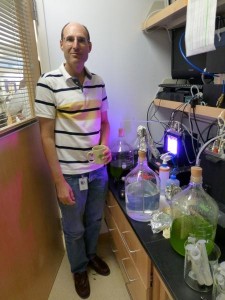ST. LOUIS, MISSOURI—2012-11-09 — /travelprnews.com/ — I am standing in an algae lab in the Donald Danforth Plant Science Center. James Umen, a principal investigator, opens a magic cabinet and—lo and behold!—it’s an amazing blue and red light show that’s mesmerizing, though nobody ever gets to see it.
What I’m looking at, under an ideal set of grow lights, is a strain of algae that could one day be used to make gasoline, diesel or jet fuel. Yes, these don’t have to be “fossil fuels”—we can grow them in ponds or even in warehouses. Umen, whose appointment at the Danforth is through the Enterprise Rent-a-Car Institute for Renewable Fuels, points out that we don’t know a whole lot about the hundreds of thousands of different algae types on our planet.
“This lab is entirely dedicated to understanding the cell biology of green algae,” Umen said. “We’ve cultivated corn for 5,000 years, but we’re just at the beginning with algae. This is a form of bio-prospecting. Many species make some oil—we’re looking for not just the most productive algae, but the most suitable algae.” Some forms that make a lot of lipid oil—the base for fuels—are hard to handle, it seems. Botryococcus braunii is an example of an algae that “just oozes oil,” Umen said, but is also fairly robust.
The green stuff—also known as pond scum and the bane of swimming pool owners like me—was first considered for fuel under President Jimmy Carter—his Aquatic Species Program, run by the National Renewable Energy Laboratory—looked at 3,000 strains and concluded there was promise there. The numbers aren’t horrible—scientists could produce 10 million gallons of biodiesel per year from a 100-acre algae plant. It would take an estimated 95 million acres of such plants to produce 140 billion gallons of fuel and replace the stuff we dig out of the ground.
Half of algae’s weight can be oil, so it’s simply a matter of extracting that oil from the cell walls. There are several ways of doing that, and the challenges aren’t insurmountable. Finding the right algae is the big hurdle now.
Umen is working with a strain that the Department of Energy said was “useless” because it doesn’t produce enough oil, but he’s modifying and breeding improved versions, not to mention “starving” it to encourage greater production. His team is looking for a biological switch they can turn on to make the algae churn out more oil than it would in its unmodified state.
Companies are already making fuel from algae. Solazyme, for instance, delivered 1,500 gallons of algae jet fuel to the Navy in 2010. That branch of the service said it wants to have at least 50 percent of its fleet running on renewable fuels by 2020, and Navy Secretary Ray Mabus is a vocal proponent (though he got some grief about it during the campaign from Senator John McCain and others). What we don’t have yet is commercial-grade algae fuel production.
You may wonder what algae fuel has to do with Enterprise Rent-a-Car, because Danforth’s science isn’t going to result in cheap fill-ups for the company’s more than one million cars and trucks (the largest rental fleet in the country) anytime soon. According to Enterprise spokeswoman Lisa Martini, the company’s foundation pledged $25 million to establish its center in 2007. The goal is fairly clear–to create next-generation alternative fuel technology from environmentally friendly plant and algae sources.
Danforth does far more than algae; a tour revealed all kinds of green plants growing in greenhouses, some of them tropical warm and others chilled. From switchgrass, miscanthus and sweet sorghum to oil-bearing seeds, they’re all being tested for their biofuel potential. Todd Mockler’s lab, for instance, is working with energy grasses. He proudly showed off $1 million in robotic machinery that can test the properties of new strains far faster than any human can. “What we’re doing would be impossible without automation,” he said. “It would take years.” The scientists have incentives to make this work produce results. Right next door to Danforth is BRDG Park, a hot house of startup companies looking to commercialize the center’s intellectual property.
James Carrington, Danforth’s president, admits that biofuels have to compete with ultra-affordable natural gas in today’s marketplace. “Incentives have to be in place,” he said. “That’s what will put wind in the sails for biofuels. What will the winner be? We’re not sure yet, especially since fossil fuels remain very competitive. I’d have to say that the phrase ‘energy independence’ has a bit of a mirage component.” Danforth does benefit from a wide array of federal grants, from the Department of Energy, Department of Agriculture and the National Science Foundation, among others.
Energy independence, Carrington said, “is hard to achieve.” Indeed it is, but it’s also exciting to see cutting-edge research that could get us there.
###

